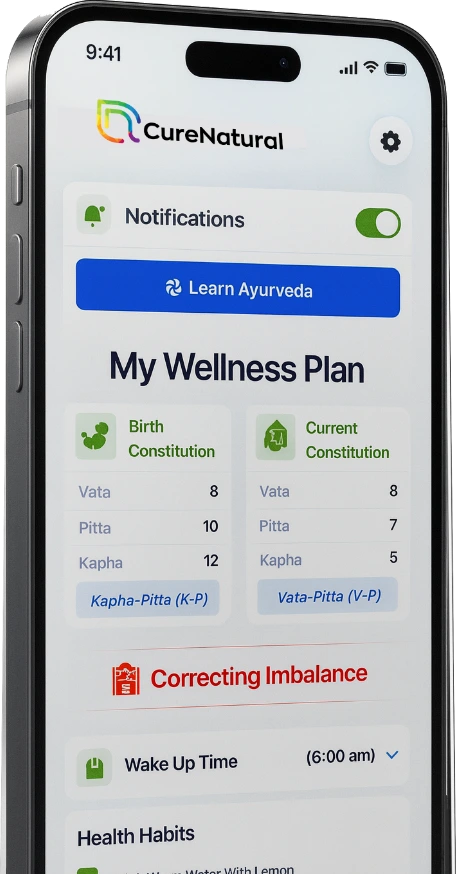Dinacharya: Ayurveda Daily Routine for Wellness
Are you tired of feeling sluggish and unenergetic all day? Imagine starting your day with a routine that boosts your energy and sets you up for overall wellness. Ayurvedic daily routine, also known as Dinacharya, is an ancient practice. It promotes self-care and wellness by aligning our body with nature’s rhythms. By adding simple habits to your daily routine, you can see a big improvement in your health. This ancient practice shows the importance of aligning our daily activities with nature. By adopting an Ayurvedic daily routine, you can connect more deeply with your body and the world around you.Key Takeaways
- Understand the concept of Dinacharya and its benefits
- Learn how to incorporate simple Ayurvedic habits into your daily routine
- Discover the importance of synchronizing your daily activities with nature’s rhythms
- Experience the benefits of improved overall wellness
- Cultivate a deeper connection with your body and the natural world
The Ancient Science of Daily Routine in Ayurveda
Dinacharya comes from Sanskrit, meaning ‘day’ and ‘activity’. It’s a key part of Ayurvedic living. It aims to improve our health by matching our daily life with nature.What is Vedic Dinacharya? Dinacharya Meaning and Historical Context
Vedic Dinacharya means daily routines from the Vedic tradition. It was used by ancient Indians to stay healthy. It shows that our daily habits greatly affect our health. By following Dinacharya, we can get healthier and find life balance.The Connection Between Dinacharya and Ritucharya
Dinacharya and Ritucharya work together in Ayurveda. Dinacharya is about daily routines, while Ritucharya is about seasonal ones. They help our lifestyle fit both daily and seasonal changes. This approach keeps the three doshas—Vata, Pitta, and Kapha—in balance.How Daily Routines Influence Doshas and Overall Health
Dinacharya’s daily routines are key to dosha balance. A consistent routine prevents health problems. For example, waking up early boosts mental and physical health. The table below shows Dinacharya’s structured daily living. It includes practices for health and balance.
The table below shows Dinacharya’s structured daily living. It includes practices for health and balance.| Time | Activity | Benefit |
|---|---|---|
| Pre-dawn | Waking up, meditation | Mental clarity, spiritual growth |
| Morning | Exercise, yoga | Physical health, flexibility |
| Evening | Relaxation, dinner | Digestion, restful sleep |
The Science Behind Ayurvedic Daily Routines
Learning about Ayurvedic daily routines can change how we see health and wellness. Dinacharya is all about matching our activities with nature’s rhythms. This helps us find balance and harmony.Aligning with Nature’s Rhythms: The Three Doshas and Time of Day
The three doshas – Vata, Pitta, and Kapha – are key in Ayurvedic routines. Each dosha has a time of day and affects our body in different ways. For example, the Kapha morning is best for meditation and yoga.
Modern Scientific Research Supporting Dinacharya Practices
Recent studies back up Dinacharya’s benefits. They show how morning light affects our circadian rhythms and how meditation reduces stress.The Ayurvedic Clock: Understanding Time Cycles
The Ayurvedic clock has six periods, each linked to a dosha. Knowing these cycles helps us plan our day with nature’s rhythms. This boosts our well-being.| Time | Dosha | Recommended Activities |
|---|---|---|
| 6:00-10:00 AM | Kapha | Yoga, Meditation |
| 10:00 AM-2:00 PM | Pitta | Work, Creative Activities |
| 2:00-6:00 PM | Vata | Physical Activity, Creative Pursuits |
5 Powerful ways to Charge up your Ayurvedic Daily Routine
Ayurvedic daily routines, or Dinacharya, boost your health and energy. Simple practices in your daily schedule can greatly improve your well-being.5 Powerful Tips to Charge the Day with Health
Here are some tips to enhance your Ayurvedic daily routine:- Wake Up Early: Rising with the sun helps regulate your body’s clock and boosts mental clarity.
- Oil Massage (Abhyanga): A self-massage with warm oil nourishes your skin, calms your mind, and prepares your body for the day.
- Meditation and Pranayama: Morning mindfulness practices reduce stress and increase energy.
- Hydrate and Nourish: Warm water and a balanced breakfast kickstart your metabolism and provide essential nutrients.
- Exercise and Movement: Physical activity, like yoga or a brisk walk, improves circulation, boosts mood, and enhances health.
A Chart to Help You Visualize your Ayurveda Daily Routine
Using a chart or planner can help plan and stick to your Ayurvedic routine. It makes your daily schedule clear and ensures you include all necessary practices. An Ayurveda Dinacharya chart has columns for time, activity, and dosha. By filling it out, you create a routine that meets your specific needs and health goals.Morning Rituals in Dinacharya Ayurveda
Morning rituals are key in Dinacharya, helping you start the day right. They align with your body’s natural rhythms and the environment. This sets the stage for a day full of wellness and energy.Waking During Brahma Muhurta (Pre-dawn Hours)
It’s best to wake up during Brahma Muhurta, before dawn. This time, from 4:00 AM to 6:00 AM, is perfect for spiritual growth. It offers a calm start to the day, setting a positive note.Oral Hygiene Practices: Tongue Scraping and Oil Pulling
Good oral hygiene is vital in the morning. Tongue scraping and oil pulling are recommended. Tongue scraping removes bacteria, while oil pulling detoxifies and boosts oral health.Self-Massage (Abhyanga): Techniques and Benefits
Abhyanga, or self-massage, is a key ritual. It involves massaging warm oil on your skin to nourish it. This improves circulation, calms the mind, and readies your body for the day.Morning Exercise: Yoga, Pranayama, and Movement
Morning exercise is essential for energizing you. Yoga, pranayama, and gentle movements are recommended. They boost flexibility, balance, and strength, preparing you for the day. Adding these morning rituals to your routine boosts your well-being. It sets you up for a day filled with energy, clarity, and purpose.Midday Practices for Optimal Health and Energy
Ayurveda teaches us the importance of midday routines for health and energy. As the day goes on, our bodies need nourishment and balance. This helps keep our energy up and supports our well-being.Ayurvedic Approach to Mindful Eating
Mindful eating is key in Ayurveda, especially at midday. It means eating a meal that fits your dosha or body type. Eating calmly, enjoying each bite, and avoiding distractions are important. This not only helps with digestion but also brings balance and satisfaction. Mindful eating tips:- Eat in a quiet, comfortable space
- Avoid eating in front of screens
- Chew slowly and thoroughly
- Stop eating when you feel satisfied, not full
Work, Activity, and Rest Recommendations
It’s important to balance work, activity, and rest at midday. Ayurveda says to take a short break after lunch to relax. For those with Pitta or Kapha types, some physical activity is good. But, those with Vata should rest more.| Dosha | Recommended Activity | Rest Duration |
|---|---|---|
| Vata | Light stretching | 20-30 minutes |
| Pitta | Moderate exercise | 15-20 minutes |
| Kapha | Vigorous activity | 10-15 minutes |
Afternoon Practices to Balance Pitta Energy
Midday is when Pitta energy is at its peak. It’s important to balance this with cooling activities. Meditation or a walk in the shade can help. Also, eating cooling foods and drinks keeps thermal balance. Here are some ways to balance Pitta:- Drinking cool water
- Eating cooling foods like cucumber and yogurt
- Engaging in relaxing activities
Evening Rituals for Restoration and Balance
Adding evening rituals to your daily routine can change your life. As the day ends, it’s key to relax and get ready for sleep. This helps your body and mind relax.Dinner Guidelines According to Ayurvedic Principles
Ayurveda says dinner should be between 6 to 7 PM. This helps with digestion and sleep. Choose warm, nourishing foods that are easy to digest. Stay away from heavy, oily, or cold foods at night. They can mess with digestion and cause imbalances. A good dinner might include:- Warm, spiced soups
- Stews with veggies and grains
- Herbal teas like peppermint or chamomile
Calming Activities for the Kapha Time of Day
In the evening, do calming things to balance Kapha energy. Gentle yoga, reading, or soft music are great. Avoid things that excite you or bright lights and screens, as they can keep you awake.Preparing Mind and Body for Restful Sleep
For better sleep, try meditation, deep breathing, or a warm bath. Keep your bedroom cool, dark, and quiet. A regular bedtime routine tells your body it’s time to sleep, leading to deeper rest. Ayurvedic experts say, “The quality of your sleep is directly related to the quality of your wakefulness.” Adding these evening rituals to your routine can greatly improve your health and life quality.| Evening Ritual | Benefits |
|---|---|
| Warm Dinner | Easy digestion, promotes restful sleep |
| Calming Activities | Balances Kapha energy, reduces stress |
| Bedtime Routine | Improves sleep quality, enhances restfulness |
Seasonal Adjustments to Your Dinacharya Practice
Ayurvedic experts say we should change our daily routines with the seasons to stay healthy. This idea links Dinacharya (daily routine) with Ritucharya (seasonal routine). By adjusting our Dinacharya with the seasons, we can live in harmony with nature and stay healthy.Winter Routines: Nourishing Vata During Hemanta and Shishira
In winter, Hemanta and Shishira, we need to warm and moisturize our bodies. We can do this by:- Eating warm, nourishing foods
- Doing oil massages (Abhyanga) to keep our skin moist
- Doing gentle exercises to keep warm and circulate blood
Spring and Summer Practices: Cooling Pitta During Vasanta and Grishma
In spring (Vasanta) and summer (Grishma), we focus on cooling and calming Pitta. We should:- Eat cooling foods and drinks to lower heat
- Do cooling yoga and avoid hot places
- Use herbs and plants that cool us down
Monsoon and Autumn Considerations: Balancing Kapha During Varsha and Sharad
In the monsoon (Varsha) and autumn (Sharad), we aim to balance Kapha. We should:- Avoid heavy, damp foods that make Kapha worse
- Do activities that make us feel dry and light
- Use warm spices to fight dampness
Creating Your Personal Dinacharya Practice
A personalized Dinacharya practice can bring balance and harmony to your life. To make a daily routine that fits you, understand your unique traits and dosha.Identifying Your Dominant Dosha and Individual Needs
Knowing your dominant dosha is key to a personalized Dinacharya practice. Your dosha shapes your strengths, weaknesses, and tendencies. Look at your body type, skin type, and personality to find your dosha.- If you’re predominantly Vata, you may be slender, creative, and prone to anxiety.
- If you’re predominantly Pitta, you may be fiery, ambitious, and prone to anger.
- If you’re predominantly Kapha, you may be calm, gentle, and prone to lethargy.
Starting Small: Implementing Sustainable Daily Habits
Begin your Dinacharya practice with small, achievable steps. This could mean waking up 15 minutes earlier for yoga or meditation. Or, add a new healthy habit to your day. Tips for starting small:- Start with one or two new habits and gradually add more.
- Be consistent and make it a part of your daily routine.
- Be patient and kind to yourself as you adapt to new habits.
Using an Ayurveda Dinacharya Chart for Guidance
An Ayurveda Dinacharya chart is a great tool for planning your day. It shows the daily cycles and helps you plan activities based on your dosha.Tracking Progress and Making Dosha-Specific Adjustments
As you move forward with Dinacharya, track your progress and adjust as needed. Keep a journal to monitor your energy, mood, and well-being. Dosha-specific adjustments:- For Vata, focus on grounding and calming practices.
- For Pitta, incorporate cooling and relaxing activities.
- For Kapha, engage in stimulating and invigorating practices.
Navigating Busy Schedules and Time Constraints
Managing a Dinacharya practice with a busy schedule can be tough. Prioritize your routine and make it a must-do part of your day. Tips for busy schedules:- Wake up earlier to fit in your Dinacharya practice.
- Use your lunch break to practice yoga or meditation.
- Wind down before bed with a relaxing routine.
Adapting Ancient Practices for Contemporary Lifestyles
Ayurveda can fit into today’s fast-paced world. Be flexible and creative in adding Dinacharya principles to your life. Modern adaptations:- Use technology to track your progress and stay on schedule.
- Incorporate modern exercise routines, such as jogging or weightlifting.
- Make healthy food choices that align with your dosha.
Strategies for Consistency and Long-Term Commitment
Consistency is key to enjoying Dinacharya’s benefits. To stay committed, make your practice enjoyable and sustainable. Tips for consistency:- Make it a habit by incorporating it into your daily routine.
- Find a community or accountability partner to support you.
- Celebrate your progress and milestones along the way.
Conclusion: Embracing the Wisdom of Dinacharya Ayurveda (Ayurvedic daily routine) for Lifelong Wellness
Embracing Dinacharya, the ancient Ayurvedic daily routine, can change our lives for the better. It helps us live in harmony with nature’s cycles. This way, we can improve our health and feel more connected to the world. Dinacharya includes morning rituals like tongue scraping and self-massage. It also involves adjusting our habits with the seasons to balance our doshas. By doing these practices daily, we can feel better physically, mentally, and emotionally. Following an Ayurvedic daily routine has many benefits. Dinacharya is flexible, so we can make it fit our own needs and body types. This holistic approach helps us find balance and harmony, leading to lifelong wellness. By adding Dinacharya to our busy lives, we can learn from Ayurveda again. We’ll grow a deeper connection with ourselves and the world around us.FAQ
What is Dinacharya in Ayurveda?
Dinacharya is a Sanskrit term for daily routines in Ayurveda, a traditional Indian medicine. It includes practices and rituals for physical, mental, and spiritual health.
What is the significance of Dinacharya in Ayurvedic practice?
Dinacharya is key in Ayurvedic practice. It helps people follow nature’s rhythms, balance their doshas, and stay healthy.
How does Dinacharya relate to Ritucharya?
Dinacharya and Ritucharya are connected in Ayurveda. Dinacharya is about daily routines, while Ritucharya is about seasonal routines. Both are vital for balance and adapting to the environment.
What is the Ayurvedic clock, and how does it relate to Dinacharya?
The Ayurvedic clock divides the day into cycles, each linked to a dosha. It helps plan daily routines based on natural day rhythms.
How can I create a personal Dinacharya practice?
Start by figuring out your dominant dosha and needs. Then, make small changes to your routine. Use an Ayurveda Dinacharya chart for guidance.
What are some common challenges in maintaining Dinacharya in modern life?
Challenges include busy schedules, adapting ancient practices to today, and staying consistent.
How can I balance my doshas through Dinacharya practices?
Balance your doshas by adding practices that counteract your dominant dosha. For example, if Pitta is your dominant dosha, try yoga and meditation to calm your energy.
What are some morning rituals in Dinacharya?
Morning rituals include waking up early, tongue scraping, oil pulling, self-massage, and yoga or pranayama.
How can I adjust my Dinacharya practice according to the seasons?
Adjust your Dinacharya by adding seasonal routines that nourish and balance your doshas. For example, in winter, use warm, nourishing foods and practices to nourish Vata.
How does CureNatural help with Dinacharya or maintaining a daily routine?
We have two ways to help you with your healthy daily routine for ayurveda. Head over to our Ayurveda Mobile App and download the app that has built-in ayurveda body constitution analysis and daily wellness plans, with healthy habits, activities for spiritual & mind balance, physical activities, foods and herbal/supplementation. Second method is to head over to our Ayurveda consultation for custom wellness plan, if you would like a practitioner to create a routine specifically for you.




